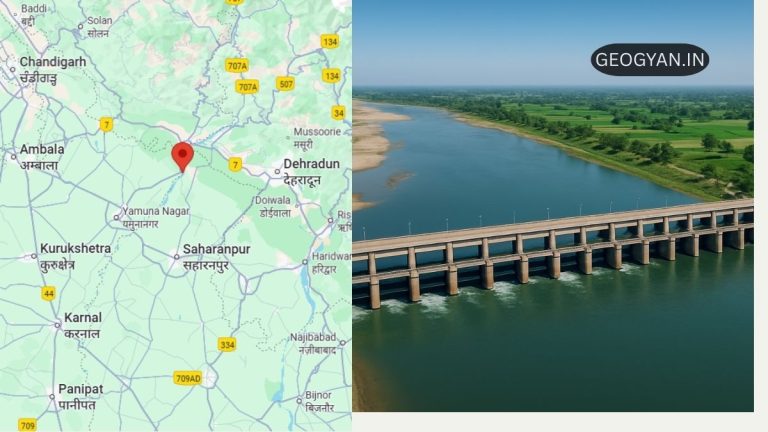Estimated reading time: 6 minutes
For geography students preparing for competitive exams like UGC NET, UPSC, RPSC, KVS, NVS, DSSSB, HPSC, HTET, RTET, UPPCS, and BPSC, comprehending natural occurrences like cloudbursts is imperative. Cloudbursts are abrupt, torrential rainfall incidents capable of inflicting substantial damage within a brief duration. This blog post presents a comprehensive analysis of cloudbursts, encompassing their underlying causes, adverse impacts, and the regions most susceptible to these events.
Table of contents
Introduction
Cloudbursts are sudden, intense rainfall events that can cause significant damage in a short period. Understanding cloudbursts is crucial for environmental science and geography enthusiasts, as well as for those living in vulnerable regions.In this blog post, we will explore the intriguing phenomenon of cloudbursts, delving into their causes, effects, and the essential steps we can take to prepare for their impact.
What is a Cloudburst?
A cloudburst is a sudden, heavy rainfall event, typically defined as 100 mm or more of rain falling within an hour over a small area. Unlike regular rainfall, cloudbursts are highly localized and can lead to severe flooding and landslides. For instance, the cloudburst in Leh, Ladakh in 2010 resulted in devastating floods, affecting thousands of people.
Causes of Cloudbursts
Cloudbursts occur due to specific meteorological conditions. They are often associated with cumulonimbus clouds, which are towering clouds with a characteristic anvil shape. These clouds can grow up to 12-15 kilometers in height, reaching into the stratosphere. Cumulonimbus clouds hold large amounts of water, which can be released suddenly due to factors like orographic lift (when moist air is lifted over mountains) and strong moisture convergence (when winds from different directions meet, causing the air to rise).
Climate change is also believed to increase the frequency and intensity of cloudbursts due to the increased water vapor content in the atmosphere. Cloudbursts can have devastating effects, causing flash floods, mudslides, and damage to property and infrastructure.
Effects of Cloudbursts
Cloudbursts bring immediate consequences such as severe flooding and landslides, resulting in tragic loss of lives and property. A recent example is the cloudburst in Kulgam, Kashmir, which triggered flash floods, damaging homes and infrastructure. Long-term effects include soil erosion and alterations to local ecosystems. Furthermore, cloudbursts can disrupt communities, leading to displacement and significant economic losses, impacting socio-economic conditions.

Regions Prone to Cloudbursts
Certain regions are more susceptible to cloudbursts due to their geographical and climatic conditions. The Himalayan region, including states like Uttarakhand and Himachal Pradesh, frequently experiences cloudbursts. Similarly, the Western Ghats and northeastern states of India are also prone to these events. Factors such as mountainous terrain and high moisture levels make these regions vulnerable.
| Date | Location | Details |
| May 4, 2018 | Belagavi, Karnataka | A cloudburst resulted in 95 mm of rain in an hour. No significant damage. |
| May 12, 2021 | Tehri, Chamoli, Uttarakhand | Cloudburst reported no significant casualties or damage. |
| July 28, 2021 | Hunzar, Kishtwar, Jammu & Kashmir | Cloudburst caused flash floods, resulting in 26 deaths and 17 injuries. |
| October 20, 2021 | Pethanaickenpalayam, Tamil Nadu | Cloudburst led to 213 mm of rain in a single day, causing local flooding. |
| July 22, 2023 | Kulgam, Kashmir | Cloudburst triggered flash floods, damaging homes and infrastructure. |
| August 19, 2022 | Dharamshala, Himachal Pradesh | Cloudburst caused flash floods, damaging roads and properties. |
| July 8, 2022 | Amarnath, Jammu & Kashmir | Cloudburst during pilgrimage, resulting in 16 deaths and several injuries. |
| August 21, 2023 | Rudraprayag, Uttarakhand | Cloudburst led to flash floods, causing significant damage to infrastructure. |
| September 3, 2023 | Mandi, Himachal Pradesh | Cloudburst resulted in heavy rainfall, leading to landslides and road blockages. |
Predicting and Monitoring Cloudbursts
Predicting cloudbursts remains a challenge due to their sudden nature. However, advancements in technology, such as satellite imagery and automatic weather stations, have improved monitoring capabilities. The India Meteorological Department (IMD) is enhancing its network to provide more accurate forecasts, which can help in early warning and preparedness.
Mitigation and Preparedness
To mitigate the impact of cloudbursts, it is essential to have effective disaster management plans in place. Community awareness and education play a crucial role in preparedness. Governments and local authorities should implement policies that promote sustainable development and reduce vulnerability. For instance, constructing proper drainage systems and avoiding construction in high-risk areas can significantly reduce damage.
Conclusion
Cloudbursts are a natural phenomenon with potentially devastating effects. Understanding their causes and impacts, and being prepared, can help mitigate their adverse effects. Continued research and technological advancements are essential for improving prediction and preparedness. Stay informed and take proactive measures to protect yourself and your community.
Test Your Knowledge with MCQs
- What is a cloudburst?
A. A sudden, intense rainfall event
B. A type of cloud formation
C. A weather phenomenon caused by climate change
D. A natural disaster resulting from volcanic eruptions - Which of the following is a characteristic feature of a cloudburst?
A. High wind speeds
B. Large hail
C. Torrential rainfall
D. Lightning and thunder - What is the minimum amount of rainfall required to be classified as a cloudburst?
A. 25 mm
B. 50 mm
C. 75 mm
D. 100 mm - Which cloud type is commonly associated with cloudbursts?
A. Cumulonimbus
B. Stratus
C. Cirrus
D. Cumulus - What is the primary cause of cloudbursts?
A. Orographic lift
B. Strong moisture convergence
C. Climate change
D. All of the above - Which region in India is most susceptible to cloudbursts?
A. Himalayan region
B. Western Ghatsats
C. Northeastern states
D. All of the above - What is the potential impact of cloudbursts on communities?
A. Flash floods
B. Landslides
C. Property damage
D. All of the above - How can communities prepare for cloudbursts?
A. Constructing proper drainage systems
B. Avoiding construction in high-risk areas
C. Community awareness and education
D. All of the above - Which technology has improved monitoring capabilities for cloudbursts?
A. Satellite imagery
B. Automatic weather stations
C. Radar systems
D. All of the above - What is the role of the India Meteorological Department (IMD) in cloudburst management?
A. Providing accurate forecasts
B. Implementing disaster management plans
C. Educating communities
D. None of the above
Answers:
- A
- C
- D
- A
- D
- D
- D
- D
- D
- A
FAQs
A cloudburst is a sudden, intense rainfall event where 100 mm or more rain falls within an hour over a small area. It can cause severe flooding and landslides.
Cloudbursts are caused by specific meteorological conditions, including the presence of cumulonimbus clouds, orographic lift, and strong moisture convergence. Climate change also plays a role in increasing their frequency.
Predicting cloudbursts is challenging, but advancements in satellite imagery and weather monitoring systems have improved forecasting capabilities.




























